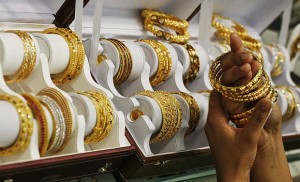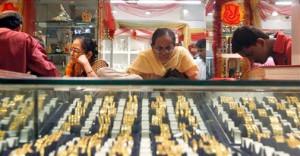You can start small by putting money in gold ETFs and e-gold
In 1492 when Christopher Columbus sailed West, he was hoping to get to India faster by avoiding the long traditional eastward trading route between Europe and Asia. He managed to convince King Ferdinand and Queen Isabella to finance it by promising to bring back heaps of gold on his return from the rich Indian subcontinent. This trip marked the beginning of the European gold fever, which prompted people to go to the ends of the world in search of the precious yellow metal.
Today we are seeing a similar phenomenon in India, which has been called by some commentators “the Indian gold rush”. India’s gold imports grew 12 per cent year-on-year between April 2012 and February 2013, despite a 2 per cent increase in import duty on the precious metal (from 4 per cent to 6 per cent). The bulk of the buying started in January when globally the price of gold spiralled downwards.
I am still to meet an Indian who has never invested in gold, that is, has never bought or owned a piece of gold jewellery. However, there is more to gold investments than buying a lot of bling bling from your family jeweller. If you are considering investing in gold, you should first get to know all your options.
There are two main ways you can invest in gold — either you can invest through a gold exchange-traded fund (ETF), or you can buy physical gold.
Gold ETF: Investing in gold ETFs is a lot like investing in equities, because you are actually investing in the gold ETF index. Investing in gold through this route enables you to immediately react to any changes in the price of gold as you can buy and sell it very quickly, any time during market hours. It also ends your worries about how to keep your gold safe and avoids any costs associated with the storage of actual gold. In fact, Warren Buffet, one of the richest men in the world, who has never invested in gold (in any form), calls it a “goose that just sits there and eats insurance and storage and a few things like that”. But never mind him, he said a lot of other funny things about gold.
If investing in gold ETF sounds attractive to you, there are two ways you can go about it:
>> You can invest in gold price ETF: A gold price ETF fund will buy a lot of real gold, which they will then divide into small shares. These shares are what you buy when you invest in a gold ETF and their cost is based on the market price of gold. So it is a lot like buying physical gold, but somebody else is storing it for you. Normally each unit of gold ETF you own is equivalent of 1 gm of gold.
>> You can invest in gold stock through a mutual fund: This way you are actually investing in companies that are in this industry, mostly in gold mining. The performance of your investment would be linked to the performance of these companies alone, not of gold. So, as long as the gold industry is doing well, your investments should also do well.
A product similar to gold ETF is e-gold. This is the newest fad on the market, so very few people are familiar with it. It is a lot like investing in gold price ETF, however, your units can also be exchange for real gold at any time should you wish to do so. You can buy it through the National Spot Exchange (NSEL) electronic platform, but bear in mind that even if you never exchange your units for gold, your investment will be treated as real gold for taxation purposes.
Physical gold: Most Indian banks can sell you gold coins and bars but will normally charge a premium for this service. Add to that the cost of making, storage and insurance, and we are no longer looking at the smartest way of investing in it. Not to mention that from a tax perspective, this is the most disadvantageous way to buy the metal because capital gains tax of 20 per cent with indexation applies just three years after your initial investment. So, despite all these drawbacks, why would you still want to invest in real gold?
And last but not least, you can, and probably will, buy gold jewellery. It may not be the savviest financial decision, but the look of joy on your daughter’s face may be worth more to you than any potential monetary returns. Add to that the status and tradition values added to expensive ornaments and we have a clear favourite with the Indian buyers.
(Elena Petrov is wealth manager at the India office of deVere Group, the world’s largest independent international financial consultancy. Her target clients include expatriates, returning NRIs and high net worth individuals interested in investing offshore)


